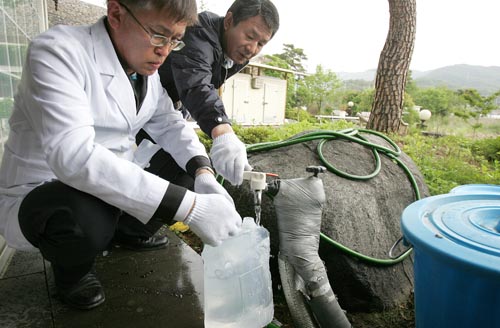Witness saw soldiers bury canisters at Camp Carroll

Inspectors take samples of underground water in the area around Camp Carroll on Saturday. The underground water is used as drinking water by residents in Chilgok County, where Camp Carroll is located. By Kong Jeong-sik
After a news report last week said that the U.S. military allegedly buried highly toxic Agent Orange - used as a defoliant during the Vietnam War - at one of its camps in Korea citing three veterans, a resident in Chilgok County of North Gyeongsang told the JoongAng Ilbo that he saw U.S. soldiers spending days digging the ground to bury something.
A 51-year-old taxi driver surnamed Park told the JoongAng Ilbo on Saturday that he and his friends saw from a mountain near Camp Carroll that U.S. soldiers were digging for days in the summer of 1978.
Park, a high school dropout, recalled that U.S. soldiers used to dump garbage, including expired combat rations, in the village by covering them with earth.
He recalled that he and his neighbors went to the garbage site hoping to find combat rations and anything of value that they could sell.
“When we saw soldiers digging, my friends and I instantly thought they’re burying something good again so we later went to the site and started digging,” Park said. “Overturning our expectations, what we thought were C-rations turned out to be yellow containers when we dug about 2 meters (6.5 feet) below the ground.”
Park said he and his friends put the dirt back and left the scene because they feared the containers held radioactive material. Park said soldiers dug the ground in the daytime and trucks came in and out of the site in the nighttime.
“It was easy for civilians to get into the area because the area wasn’t surrounded with barbed wire at that time and the dumping area was located away from the base,” Park said. “So some even drove a cultivator to the area and loaded valuable dumped stuff including combat rations and iron rods.”
Looking down to Camp Carroll from the rooftop of Chilgok Education Culture Welfare Center building located next to the military base, Park said the area where he discovered buried yellow drum containers is now used as Camp Carroll’s No. 3 helipad.
Park reported his recollections to Chilgok police on Saturday.
Meanwhile, the U.S. and Korean governments yesterday agreed to swiftly conduct a joint investigation into the alleged toxic dump.
“The governments of Korea and the U.S. have agreed to speedily proceed for a joint investigation into the alleged burial of Agent Orange at the Camp Carroll,” Yook Dong-han, a senior official the Prime Minister’s Office, said yesterday. “The U.S. government has taken this issue seriously and both governments agreed to share information on the camp’s environmental condition. A joint inspection team will be dispatched to the site and look into the camp.”
Yook said Walter Sharp, commander of the U.S.-Korea Combined Forces Command and the UN Command, will be in charge of the U.S. task force team.
A separate Korean government-civilian panel of residents and environmental experts is scheduled to inspect the camp today, Yook said.
By Song Yee-ho, Kim Mi-ju [mijukim@joongang.co.kr]
한글 관련 기사 [중앙일보]
‘네버 어게인 2002’ … 존슨 미 8군 사령관, 고엽제 조사 직접 나섰다
보도 3일 만에 신속 조사 합의 왜
경북 칠곡군 왜관읍에 위치한 미군 기지 캠프 캐럴의 고엽제 매몰 의혹과 관련해 미8군 존 D 존슨 사령관(중장)이 신속한 대응에 나섰다. 그는 미군 측 대응 팀장을 맡았다. 지난 19일 전 미군 병사가 캠프 캐럴 기지에 드럼통 250개 분량의 고엽제를 묻었다는 미국 방송의 보도 내용이 국내에 알려진 3일 만에 미군 측은 캠프 캐럴에 대한 한·미 공동 조사에 합의한 것이다. 이런 신속한 대응은 9년 전인 2002년 6월에 경기도 양주에서 훈련 중이던 미군 장갑차에 치여 숨진 ‘효순·미선양 사건’의 악몽 때문으로 풀이된다. 당시 미국 측은 사고 두 달이 지난 뒤에야 사과를 하는 등 책임을 회피하는 모습을 보여 전국적인 반미 촛불 시위를 불렀다. 미국은 아픈 경험을 바탕으로 지금 ‘네버 어게인(Never Again) 2002’를 위해 발 빠르게 움직이고 있다.
이런 미국 측의 움직임에 왜관읍 주민들은 긍정적인 반응을 보이면서도 걱정을 떨치지 못하고 있다.
“부대 헬기장 주변을 파보니 노란색 드럼통이 나와 깜짝 놀랐다.” 경북 칠곡군 왜관읍 주민 박모(51·택시기사)씨는 1978년 캠프 캐럴 헬기장 인근을 판 적이 있다며 이렇게 말했다. 그는 고교생이던 당시 캠프 캐럴 인근에 살았다. 당시 주민들은 현재 헬기장 주변에 묻힌 C-레이션(미군의 전투식량) 박스를 파내 가곤 했다. 그곳에는 철조망 등 울타리가 없었고 부대 건물과도 상당히 떨어져 있었다고 한다. 박씨는 “그해 여름 친구 3∼4명과 부대 뒷산에서 지켜보니 미군들이 며칠씩 땅을 파고 무엇인가 묻은 뒤 평평하게 고르는 작업을 하고 있었다”고 기억했다. 그는 좋은 물건이 있을 것으로 생각하고 미군이 없는 틈을 타 친구들과 삽과 곡괭이로 땅을 팠다. 박씨는“2m쯤 파내려 가자 노란색 드럼통이 나왔다”며 “순간 방사능 물질이 담긴 것 아니냐는 생각이 들어 곧바로 덮어 버렸다”고 말했다. 그는 “보도를 보니 당시 드럼통에 든 물질이 고엽제일 가능성이 있겠다는 생각을 했다”고 덧붙였다. 그는 이런 내용을 칠곡군청과 칠곡경찰서에 신고했다.
고엽제 피해를 의심하는 주민도 나오고 있다. 기지 내 헬기장에서 500여m 떨어진 아곡리 주민들은 2009년 여름 지하수에서 농약냄새가 나 식수용 관정을 새로 뚫었다. 주민 조병용(60)씨는 “세수를 하다 물에서 농약(제초제) 냄새가 나 군청에 신고했다”고 말했다. 주민 김모(59·여)씨는 “지하수가 고엽제에 오염된 것 아닌가 하는 의심이 든다”고 말했다. 주민들에 따르면 160여 가구 400여 명이 사는 이 마을은 지난 30여 년간 간암·폐암 등으로 20여 명이 숨지고 현재 투병 중인 사람도 6∼7명에 이른다는 것이다.
칠곡군 주민 중 암으로 숨진 사람이 전국 평균보다 많은 것으로 나타났다. 통계청의 사망원인에 따르면 2005∼2009년 칠곡군의 인구 10만 명당 암 사망자는 138.7∼161.5명으로 전국 평균인 133.8∼140.5명보다 많았다. 부경대 옥곤(환경대기과학) 교수는 “ 고엽제의 유출 여부나 유출량을 따지지 않은 채 암 발생과 연관성을 판단할 수는 없다”고 말했다.










with the Korea JoongAng Daily
To write comments, please log in to one of the accounts.
Standards Board Policy (0/250자)